
Come & see this ancient stone fortress expressed as the eighth wonder of the world. Unbelievable technical, stone methods, wall Arts with beautiful environment shows you the unlimited talent of the Sri Lankan aborigines.
This world historical monument located at Mathale District of Sri Lanka.
According to the Sri Lankan history, the king Kashyapa created this Lion’s rock for hide from his brother’s attacks.
After the king’s death the Sigiriya named as a Buddhist monastery until 14th century.
Legendary Past of Sigiriya
According to the researches of Dr Mirando Obesekara, He identify the Sigiriya as a historical turning point of Ravana. Before 50 centuries Sigiriya named as Alakamandawa (Akasa Maligawa).
The Indian ancient epic story “Ramayanaya” described the brother of Rawana (Kuwera/Waisrwana) is the owner of the Alakamandawa (Sigiriya).

According to the Ravana watha Palm leaf book, Mayadanawa is the Architecture of the Sigiriya.
He buid the Sigiriya according to instruction given by Vessamuni / Wishrawa Muni (Father of Ravana).
Finally palace was dedicated for Ravana’s Brother King Kuwera(Waishrawana).
After-wards the Ravana has banished the Kuwera & Got the Sigiriya under his Control.
History of Sigiriya
The history of Sigiriya is a long story. The rock came into being as a result of a rivalry between two brothers.
The great rock fortress, Sigiriya was built by the King Kashyapa. King Kashyapa made this great place to protect himself from his brother King Mogallana.
The Sigiriya rock is entwined with a tragic event. The heir to the throne had been King Mogallana, but King Kashyapa had taken power by force.
King Kashyapa was afraid that his brother would come back again to take back his right to the throne.
Therefore, to protect himself, he built this rock fortress. He did not want any invasion to happen by his brother.
The technology that has been used in creating the fort is excellent.
The Sigiriya rock is decorated with colorful frescos. However, Moggallana was able to defeat Kashyapa, and after that, the rock fortress was destroyed.
Earlier it used to be a Buddhist monastery, and after the palace was destroyed, it became a Buddhist monastery once again.
Sigiriya was discovered later in 1831 by Europeans. A major of the British army, Jonathan Forbes discovered Sigiriya on his way from Polonnaruwa. Many historians and archaeologists started excavating this rock fortress, and it is through the excavations that all the glory of the rock was discovered. One who goes to the top of the rock would see that it is a citadel, with gardens, and parks.
Sigiriya is a massive rock which was built for protection, and the technology that has been used is advanced. Its layout and the planning technology used in Sigiriya is extraordinary.
Arts of Sigiriya
The Sigiriya arts are of beautiful women. It is believed that the drawings are the reflections of the beautiful women who lived in King Kashyapa’s palace.
The women were drawn to resemble Apsaras. The facial expressions depicted on the woman’s face, the use of color in the paintings attract tourists.
The most typical thing in these drawings is that each of these women wears delicate three-circled tattoos around their necks.
It indicates that the women belong to King Kashyapa. They resembled supernatural and was a depiction of the grandeur of Kasyapa.
The drawings also resemble the Gupta style of painting in the Ajanta Caves in India.
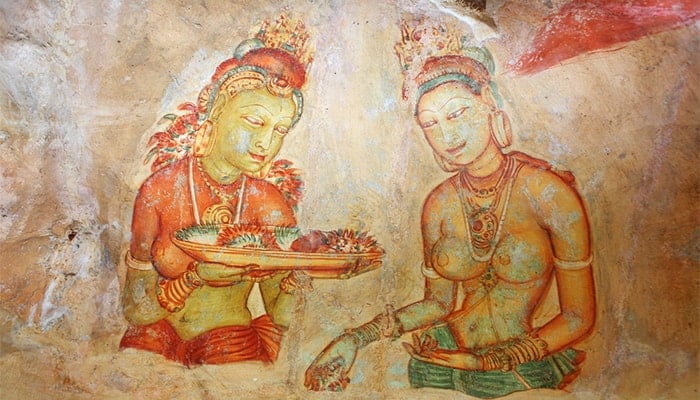
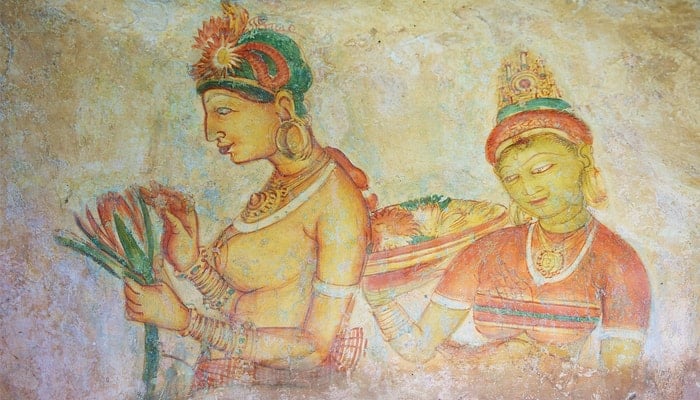
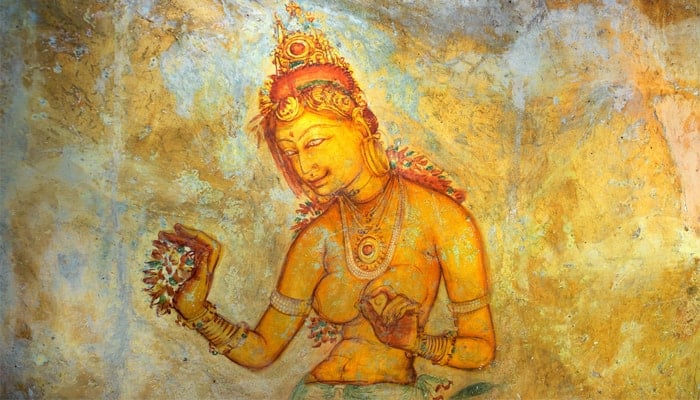

Sigiriya Frescoes and Sigiriya paintings
One of the other main attractions of Sigiriya is the Sigiriya frescoes and Sigiriya paintings. The murals can be seen once you climb the circular staircase.
The Sigiriya frescoes are the maidens with beautiful curves carrying flowers. There are dressed in heavy garments, and it is believed that they are carrying flowers to the king for blessings.
Sigiriya Lion Claws
There is a staircase in Sigiriya where you would see two enormous lion paws carved out of the rock.
It will lead up to a gigantic lion statue. It represents the pride and the strength of King Kashyapa.
The term Sigiriya derives from Sinha-Giri which means ‘Lion Rock.’ HCP Bell excavated the two enormous lion paws in 1898.
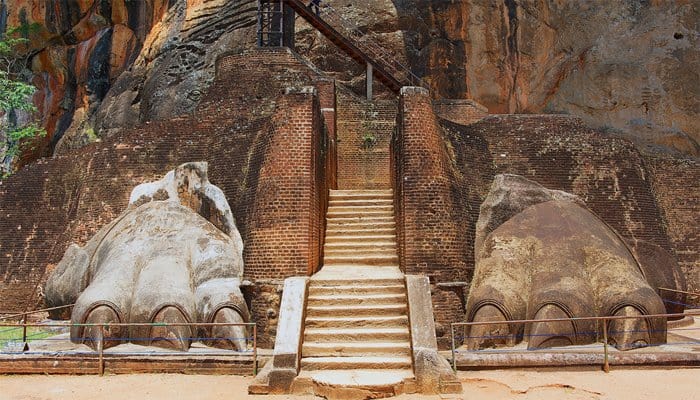
King Kashyapa

Kashyapa is the son of king Dathusena & Mugalan is the brother of him.
According to the rules of those days, after the death of Dathusena the royalty should be belongs to Mugalan.
But Kashyapa wants to get the royalty because he believed he is the one who suitable for the royalty than Mugalan.
The reason for that is Kashyapa has won the war against to south Indians.
After-wards he killed king Dathusena and got the royalty of Anuradhapura.
He selected the Sigiriya Rock as his Citadel and he was built his palace on top of the Sigiriya Rock with and amazing technology.
Sigiriya Graffiti & Mirror Wall
Sigiriya Graffiti can be seen on the lower area of the Mirror Wall. The Graffiti contains reflections on the rock.
These reflections are the collections of thoughts of the many people who have visited the Sigiriya rock.

Visitors who have visited the rock, kings, common people and pilgrims have written their thoughts on the rock. It is the beauty of the rock that they have written in verses.
The Sigiriya Graffiti gives an insight to the different people who have visited the rock, and in the graffiti, the beauty of the rock and the architecture that has been used is described.
Sigiriya Mirror Wall
The Sigiriya mirror wall is something that you should not miss when you are at the top of the rock.
It is a polished rock and is situated next to the Sigiriya maidens. The mirror wall is a parapet wall. It is a kind of a protective wall built in those ancient times.
Water Fountain and the Water Management System of Sigiriya
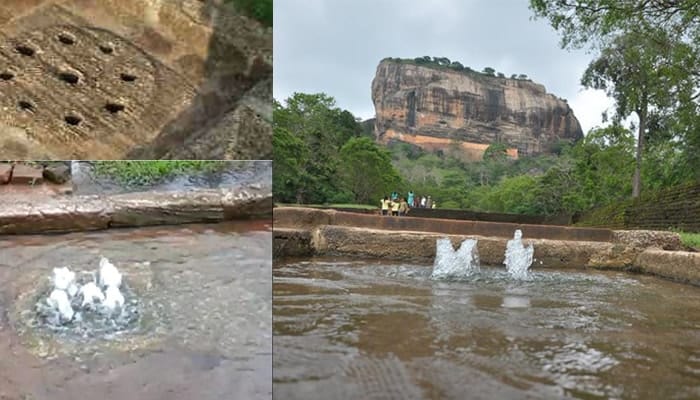
On the top of the rock, there is evidence of Water Gardens and fountains.
The technology of the water management system used on top of the rock is marvelous. The Fountain Garden is evidence of Sigiriya’s hydraulics.
There is also a miniature water garden. All these are evidence of the excellent water management systems.
Engineering Technology of Sigiriya
The layout is organized in a way that on either side of the roads to the western entrance there are rectangular pools.
In front of the pools, there are limestone fountains.
The technology used is much advanced, and it is hard to believe how there could have been such technology during the ancient times.

Garden Scaping of Sigiriya
The Sigiriya Garden Scaping structures are evidence of ancient botanical garden’s.
The landscape is eye-catching, and it is a mix of natural floral species.
The planning is well laid out. It is a wonder to look at the garden scaping which is unique to the Sigiriya rock.
City Planning of Sigiriya
On top of the rock, there is a royal palace and also gardens. The technology and architecture of the city planning are based on a square module.
It is wonderful to look at the amazing technology that has been used. Many tourists come to visit Sigiriya to look at its wonderful techniques.
Architecture of Sigiriya
The rock rises about 200 meters above the plain that it is built-in. It has two parts, the Western part which is about 90 hectares and the Eastern part, which is about 40 hectares.
If you take the architecture, the western area has a high park area, with three ramparts and two moats. The Eastern part has boulder gardens.
City Planning of Sigiriya
On top of the rock, there is a royal palace and also gardens. The technology and architecture of the city planning are based on a square module.
It is wonderful to look at the amazing technology that has been used. Many tourists come to visit Sigiriya to look at its wonderful techniques.
Architecture of Sigiriya
The rock rises about 200 meters above the plain that it is built-in. It has two parts, the Western part which is about 90 hectares and the Eastern part, which is about 40 hectares.
If you take the architecture, the western area has a high park area, with three ramparts and two moats. The Eastern part has boulder gardens.
Do you know?
- Sigiriya is a UNESCO listed world heritage site. more details
- The rock is around 200 meters tall. The stunning inscribed shows you about the talent & creativity of Sigiriya builders.
- Sigiriya opens every day from 7:00 AM – 04:00 PM
- You can easily climb the Sigiriya about 10-20 minutes from the bottom of the rock.
Come to visit the Sigiriya & enjoy the beauty of this palace. I’m sure it will be an unforgettable memory of your travel life.
When you visit top of the Sigiriya, you can see the upper palace, middle compound, lower palace, beautiful garden, creative walls, graffiti etc.
The architects have created this palace with natural air cooling & amazing watering system.





